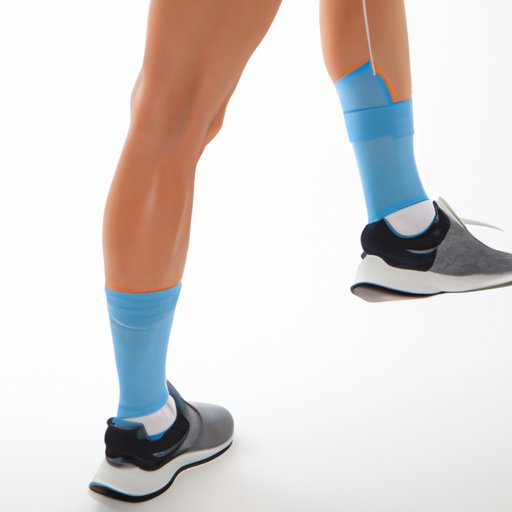Introduction
If you’re a runner, you may have experienced that dull pain in your shins known as shin splints. Shin splints, or medial tibial stress syndrome, can be a frustrating and painful injury that can significantly affect your training. It occurs when the muscles and tendons surrounding the tibia (or shinbone) become inflamed due to excessive and repetitive stress.
Preventing shin splints is crucial in maintaining a healthy running routine. In this article, we’ll explore some of the most effective techniques and exercises to help you prevent shin splints and keep you on track to reach your fitness goals.
Proper Footwear
One of the most important steps to prevent shin splints is to wear the proper footwear while running. Running shoes should have adequate cushioning and support to absorb shock and reduce the impact on your legs. Avoid running in old or worn-out shoes, as they can cause added stress to your joints and increase your risk of injury.
When selecting running shoes, consider your foot type, arch, and pronation. For example, if you have flat feet, you should choose shoes that provide additional arch support for stability. If you’re unsure about your foot type and which shoes might be best for you, consider getting a professional fitting at a specialty running store.
In addition to running shoes, consider adding orthotics or shoe inserts to provide additional support and cushioning to your feet. These can be especially helpful if you have existing foot issues, such as overpronation or plantar fasciitis.
Stretch Before You Run
Stretching before your run can help prevent shin splints by loosening up tight muscles and improving flexibility. Dynamic stretching, which involves moving while stretching, can be particularly effective. Some examples of dynamic stretches include walking lunges, leg swings, and high kicks.
Static stretching, which involves holding a stretch for a period of time, can also be helpful. This type of stretching should be done after your run, during your cool-down (which we’ll discuss in the following section).
When performing stretches, be sure to avoid bouncing, as this can cause small tears in your muscles that can lead to injury. Hold each stretch for 20-30 seconds and repeat on each side as necessary.
Gradual Increase in Intensity
One of the most common causes of shin splints is sudden and dramatic changes in training intensity. If you’re new to running or returning after a break, it’s essential to start slowly and gradually build up your training. This will give your muscles and bones time to adapt to the strain of running and reduce your risk of injury.
As a general rule, aim to increase your training intensity by no more than 10% per week. This means if you run 10 miles one week, aim to run no more than 11 miles the following week.
Be sure to pay attention to signs that you may be pushing too hard, such as increased pain, fatigue, or soreness. If you experience any of these symptoms, scale back your training intensity until you feel more comfortable.
Proper Warm-Up and Cool Down
In addition to stretching, warming up before your run and cooling down afterward can also help prevent shin splints. A warm-up can consist of light jogging or walking for a few minutes to increase blood flow and prepare your body for the activity ahead.
Cooling down after your run can help your muscles recover by reducing lactic acid buildup and stiffness. Some examples of effective cool-down exercises include leg swings, calf raises, and standing hamstring stretches.
Strength Training
Strength training exercises can be particularly helpful in preventing shin splints by strengthening the muscles surrounding the shinbone. Incorporating exercises that target your calves, shins, and ankles can improve your overall strength and stability.
Some effective exercises to incorporate into your strength training routine include calf raises, toe walks, and heel walks. These exercises help to build strength and flexibility in the muscles and tendons surrounding your shins, reducing your risk of injury.
Strength training exercises should be performed 2-3 times per week, making sure to rest for at least a day between sessions. Start with 1-2 sets of 10-15 repetitions for each exercise and gradually increase the intensity and duration as your strength improves.
Cross-Training
Another effective technique to prevent shin splints is to incorporate cross-training into your routine. Cross-training involves performing different types of exercises to improve your overall fitness and reduce the repetitive stresses of running.
Low-impact exercises such as cycling, swimming, or yoga can be excellent choices for cross-training. These exercises provide cardiovascular benefits without putting undue stress on your muscles and joints.
When incorporating cross-training activities into your routine, aim for 1-2 sessions per week, making sure to give your body time to rest and recover between sessions.
Take Rest Days
One of the most critical steps in preventing shin splints is to take rest days. Giving your body time to rest and recover is essential to reducing the risk of injury and improving your overall fitness.
As a general rule, aim for at least one rest day per week, where you avoid vigorous exercise and allow your muscles time to recover. If you’re experiencing pain or discomfort in your shins, scale back your training further and allow yourself additional time to rest.
Conclusion
Preventing shin splints requires a proactive approach to your training routine. By following these techniques and exercises, you can reduce your risk of injury and maintain your running goals. Remember to start slowly, gradually build up your training intensity, and listen to your body when it tells you to take a break. With proper footwear, stretching, strength training, and cross-training, you can keep your shins healthy and running strong.
Don’t let shin splints get in the way of your running goals- be proactive and take the necessary steps to prevent them from occurring.
